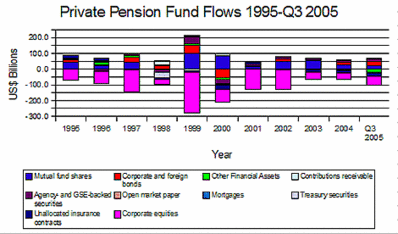Just How Useful Are Private Pension Funds?
by John Schroy filed under Fund Managers
Between 1999 and 2002, U.S. private pension funds lost US$1.2 trillion in value.
It turns out that $282.2 billion of the decline in private pension fund value over 1999 to 2002 was due to net withdrawals from these plans, but even so, the drop in market value amounted to $979.7 billion.
It would almost seem that pension fund managers had been speculating with retirement money, attempting to beat each others’ short-term performance statistics, with little interest in safeguarding the assets of plan beneficiaries.
But half of U.S. private pension funds were organized as ‘defined contribution’ plans, such as 401(k)s, in which the fundamental asset allocation decision was made not by fund managers, but by the plan beneficiaries themselves.
During the 1990s, millions of private ‘pension fund’ decisions were made not by pension fund managers but by unsophisticated workers who, believing the “Common Stock Legend“, blindly allocated their long-term assets to equity mutual funds.
In 2004, 44.4 million workers were insured by PBGC under ‘defined benefit’ private pension plans, which comes down to pension assets of about $40,000, on average, per worker — hardly enough to provide much of a ‘defined benefit’ in old age.



